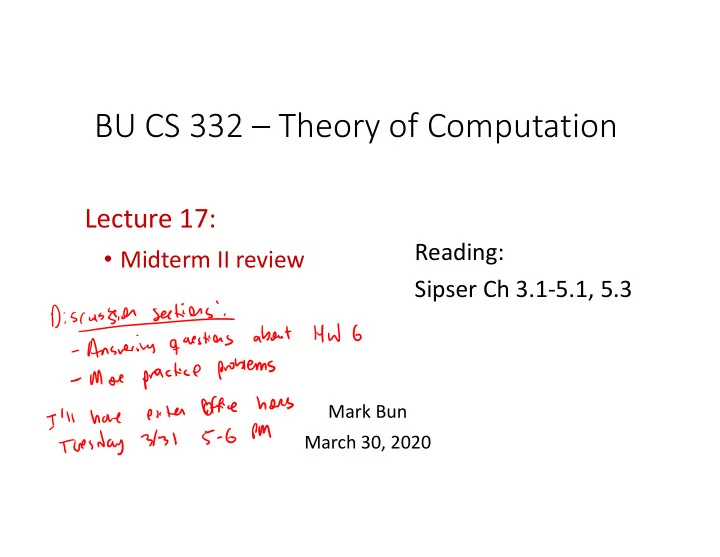

BU CS 332 – Theory of Computation Lecture 17: Reading: • Midterm II review Sipser Ch 3.1 ‐ 5.1, 5.3 Mark Bun March 30, 2020
Format of the Exam 4/1/2020 CS332 ‐ Theory of Computation 2
4/1/2020 CS332 ‐ Theory of Computation 3
4/1/2020 CS332 ‐ Theory of Computation 4
Midterm II Topics 4/1/2020 CS332 ‐ Theory of Computation 5
Turing Machines (3.1, 3.3) • Know the three different “levels of abstraction” for defining Turing machines and how to convert between them: Formal/state diagram, implementation ‐ level, and high ‐ level • Know the definition of a configuration of a TM and the formal definition of how a TM computes • Know how to “program” Turing machines by giving implementation ‐ level descriptions • Understand the Church ‐ Turing Thesis 4/1/2020 CS332 ‐ Theory of Computation 6
TM Variants (3.2) • Understand the following TM variants: Multi ‐ tape TMs, Nondeterministic TMs, Enumerators • Know how to give a simulation argument (implementation ‐ level description) to compare the power of TM variants • Understand the specific simulation arguments we’ve seen: multi ‐ tape TM by basic TM, nondeterministic TM by basic TM, enumerator by basic TM and basic TM by enumerator. 4/1/2020 CS332 ‐ Theory of Computation 7
Decidability (4.1) • Understand how to use a TM to simulate another machine (DFA, another TM) • Know the specific decidable languages from language theory that we’ve discussed, and how to decide them: ��� , ��� , ��� , ��� etc. ��� • Know how to use a reduction to one of these languages to show that a new language is decidable • (You don’t need to know details of what Chomsky Normal Form is, but understand how it is used to prove decidability of ��� ) 4/1/2020 CS332 ‐ Theory of Computation 8
Undecidability (4.2) • Know the definitions of countable and uncountable sets and how to prove countability and uncountability • Understand how diagonalization is used to prove the existence of explicit undecidable languages ( �� in the book, or �� from lecture) • Know that a language is decidable iff it is recognizable and co ‐ recognizable, and understand the proof 4/1/2020 CS332 ‐ Theory of Computation 9
Reducibility (5.1) • Understand how to use a reduction (contradiction argument) to prove that a language is undecidable • Know the reductions showing that �� , �� are undecidable �� �� �� • You are not responsible for understanding the computation history method. However, you should know that the language ��� is undecidable, and reducing from it might be useful. 4/1/2020 CS332 ‐ Theory of Computation 10
Mapping Reducibility (5.3) • Understand the definition of a computable function • Understand the definition of a mapping reduction • Know how to use mapping reductions to prove decidability, undecidability, recognizability, and unrecognizability 4/1/2020 CS332 ‐ Theory of Computation 11
Tips for Preparing Exam Solutions 4/1/2020 CS332 ‐ Theory of Computation 12
True or False • It’s all about the justification! • The logic of the argument has to be clear • Restating the question is not justification; we’re looking for some additional insight 4/1/2020 CS332 ‐ Theory of Computation 13
Simulation arguments, constructing deciders • Full credit for a clear and correct description of the new machine • Still a good idea to provide an explanation (partial credit, clarifying ambiguity) 4/1/2020 CS332 ‐ Theory of Computation 14
Undecidability proofs 4/1/2020 CS332 ‐ Theory of Computation 15
Uncountability proofs • The 2 ‐ D table is useful for thinking about diagonalization, but is not essential to the argument • The essential part of the proof is the construction of the “inverted diagonal” element, and the proof that it works 4/1/2020 CS332 ‐ Theory of Computation 16
Practice Problems 4/1/2020 CS332 ‐ Theory of Computation 17
4/1/2020 CS332 ‐ Theory of Computation 18
4/1/2020 CS332 ‐ Theory of Computation 19
4/1/2020 CS332 ‐ Theory of Computation 20
4/1/2020 CS332 ‐ Theory of Computation 21
4/1/2020 CS332 ‐ Theory of Computation 22
Decidability and Recognizability 4/1/2020 CS332 ‐ Theory of Computation 23
Let � Show that is decidable 4/1/2020 CS332 ‐ Theory of Computation 24
Prove that is recognizable 4/1/2020 CS332 ‐ Theory of Computation 25
Prove that if and are decidable, then so is 4/1/2020 CS332 ‐ Theory of Computation 26
Countable and Uncountable Sets 4/1/2020 CS332 ‐ Theory of Computation 27
Show that the set of all valid (i.e., compile without errors) C++ programs is countable 4/1/2020 CS332 ‐ Theory of Computation 28
A Celebrity Twitter Feed is an infinite sequence of ASCII strings, each with at most 140 characters. Show that the set of Celebrity Twitter Feeds is uncountable. 4/1/2020 CS332 ‐ Theory of Computation 29
Undecidability and Unrecognizability 4/1/2020 CS332 ‐ Theory of Computation 30
Prove or disprove: If and are recognizable, then so is 4/1/2020 CS332 ‐ Theory of Computation 31
Prove that the language ��∗ is undecidable 4/1/2020 CS332 ‐ Theory of Computation 32
Give a nonregular language such that or prove that none exists 4/1/2020 CS332 ‐ Theory of Computation 33
Give an undecidable language such that or prove that none exists 4/1/2020 CS332 ‐ Theory of Computation 34
Give an undecidable language such that or prove that none exists 4/1/2020 CS332 ‐ Theory of Computation 35
Recommend
More recommend